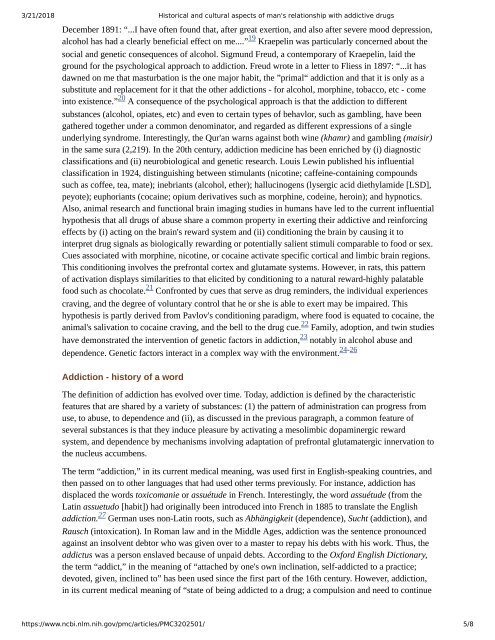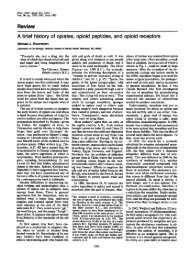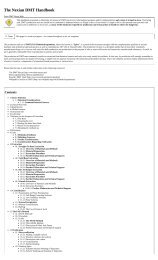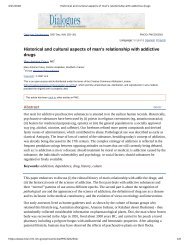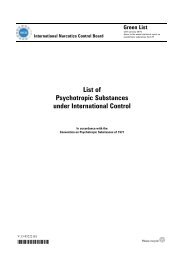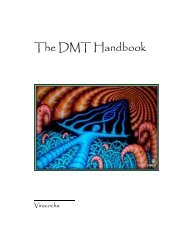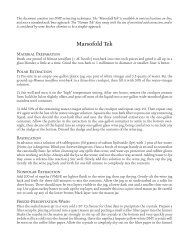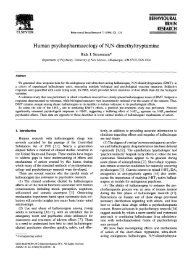Historical and cultural aspects of man's relationship with addictive drugs
Historical and cultural aspects of man's relationship with addictive drugs
Historical and cultural aspects of man's relationship with addictive drugs
You also want an ePaper? Increase the reach of your titles
YUMPU automatically turns print PDFs into web optimized ePapers that Google loves.
3/21/2018 <strong>Historical</strong> <strong>and</strong> <strong>cultural</strong> <strong>aspects</strong> <strong>of</strong> <strong>man's</strong> <strong>relationship</strong> <strong>with</strong> <strong>addictive</strong> <strong>drugs</strong><br />
December 1891: “...I have <strong>of</strong>ten found that, after great exertion, <strong>and</strong> also after severe mood depression,<br />
19<br />
alcohol has had a clearly beneficial effect on me....” Kraepelin was particularly concerned about the<br />
social <strong>and</strong> genetic consequences <strong>of</strong> alcohol. Sigmund Freud, a contemporary <strong>of</strong> Kraepelin, laid the<br />
ground for the psychological approach to addiction. Freud wrote in a letter to Fliess in 1897: “...it has<br />
dawned on me that masturbation is the one major habit, the ”primal“ addiction <strong>and</strong> that it is only as a<br />
substitute <strong>and</strong> replacement for it that the other addictions - for alcohol, morphine, tobacco, etc - come<br />
20<br />
into existence.” A consequence <strong>of</strong> the psychological approach is that the addiction to different<br />
substances (alcohol, opiates, etc) <strong>and</strong> even to certain types <strong>of</strong> behavlor, such as gambling, have been<br />
gathered together under a common denominator, <strong>and</strong> regarded as different expressions <strong>of</strong> a single<br />
underlying syndrome. Interestingly, the Qur'an warns against both wine (khamr) <strong>and</strong> gambling (maisir)<br />
in the same sura (2,219). In the 20th century, addiction medicine has been enriched by (i) diagnostic<br />
classifications <strong>and</strong> (ii) neurobiological <strong>and</strong> genetic research. Louis Lewin published his influential<br />
classification in 1924, distinguishing between stimulants (nicotine; caffeine-containing compounds<br />
such as c<strong>of</strong>fee, tea, mate); inebriants (alcohol, ether); hallucinogens (lysergic acid diethylamide [LSD],<br />
peyote); euphoriants (cocaine; opium derivatives such as morphine, codeine, heroin); <strong>and</strong> hypnotics.<br />
Also, animal research <strong>and</strong> functional brain imaging studies in humans have led to the current influential<br />
hypothesis that all <strong>drugs</strong> <strong>of</strong> abuse share a common property in exerting their <strong>addictive</strong> <strong>and</strong> reinforcing<br />
effects by (i) acting on the brain's reward system <strong>and</strong> (ii) conditioning the brain by causing it to<br />
interpret drug signals as biologically rewarding or potentially salient stimuli comparable to food or sex.<br />
Cues associated <strong>with</strong> morphine, nicotine, or cocaine activate specific cortical <strong>and</strong> limbic brain regions.<br />
This conditioning involves the prefrontal cortex <strong>and</strong> glutamate systems. However, in rats, this pattern<br />
<strong>of</strong> activation displays similarities to that elicited by conditioning to a natural reward-highly palatable<br />
21<br />
food such as chocolate. Confronted by cues that serve as drug reminders, the individual experiences<br />
craving, <strong>and</strong> the degree <strong>of</strong> voluntary control that he or she is able to exert may be impaired. This<br />
hypothesis is partly derived from Pavlov's conditioning paradigm, where food is equated to cocaine, the<br />
22<br />
animal's salivation to cocaine craving, <strong>and</strong> the bell to the drug cue. Family, adoption, <strong>and</strong> twin studies<br />
23<br />
have demonstrated the intervention <strong>of</strong> genetic factors in addiction, notably in alcohol abuse <strong>and</strong><br />
24-26<br />
dependence. Genetic factors interact in a complex way <strong>with</strong> the environment.<br />
Addiction - history <strong>of</strong> a word<br />
The definition <strong>of</strong> addiction has evolved over time. Today, addiction is defined by the characteristic<br />
features that are shared by a variety <strong>of</strong> substances: (1) the pattern <strong>of</strong> administration can progress from<br />
use, to abuse, to dependence <strong>and</strong> (ii), as discussed in the previous paragraph, a common feature <strong>of</strong><br />
several substances is that they induce pleasure by activating a mesolimbic dopaminergic reward<br />
system, <strong>and</strong> dependence by mechanisms involving adaptation <strong>of</strong> prefrontal glutamatergic innervation to<br />
the nucleus accumbens.<br />
The term “addiction,” in its current medical meaning, was used first in English-speaking countries, <strong>and</strong><br />
then passed on to other languages that had used other terms previously. For instance, addiction has<br />
displaced the words toxicomanie or assuétude in French. Interestingly, the word assuétude (from the<br />
Latin assuetudo [habit]) had originally been introduced into French in 1885 to translate the English<br />
27<br />
addiction. German uses non-Latin roots, such as Abhängigkeit (dependence), Sucht (addiction), <strong>and</strong><br />
Rausch (intoxication). In Roman law <strong>and</strong> in the Middle Ages, addiction was the sentence pronounced<br />
against an insolvent debtor who was given over to a master to repay his debts <strong>with</strong> his work. Thus, the<br />
addictus was a person enslaved because <strong>of</strong> unpaid debts. According to the Oxford English Dictionary,<br />
the term “addict,” in the meaning <strong>of</strong> “attached by one's own inclination, self-addicted to a practice;<br />
devoted, given, inclined to” has been used since the first part <strong>of</strong> the 16th century. However, addiction,<br />
in its current medical meaning <strong>of</strong> “state <strong>of</strong> being addicted to a drug; a compulsion <strong>and</strong> need to continue<br />
https://www.ncbi.nlm.nih.gov/pmc/articles/PMC3202501/ 5/8


